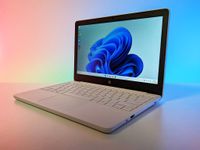Future of Windows is all about collaboration — for businesses and consumers

The history of Windows has, in a sense, always been nearly getting things done, whether it's writing a term paper, doing an Excel document, doing supercomputing, or just good ol' Minesweeper. Only the world that Windows grew upwardly in has radically changed since the mid-1990s with the growth of the internet.
Back in February, our Senior Writer Zac Bowden reported that the Surface Hub two – forth with unannounced products like HoloLens 2 and "Project Andromeda" – are function of a concerted effort congenital around collaboration in the modern workspace, along with productivity and 3D Mixed Reality. The Surface Hub 2 official reveal thisw week affirms that the primary concept behind the device is getting people to work together for idea-expression, whether they are in the same room or across the planet.
Breaking downwardly barriers
Hip jargon, like "dynamic and immersive collaboration", or more recently from Microsoft Build, "planet-scale apps", may sound like PR buzz, but information technology seems to exist all part of a program for Windows, Azure (Cosmos DB), Xbox, Kinect for Azure, and Surface.
Microsoft Whiteboard – which is still in early preview – Microsoft OneNote, Role 365, Microsoft Team, and Skype, are all nearly letting people pause down barriers. Some of that is language (Microsoft Translator), some of that is distance ("Holoportation", and some is personal (My People on the Windows Taskbar).
All these apps, software, and at present even hardware, are very different from the legacy of the desktop PC. The sometime concept of a terminal that workers slaved behind in isolation (salve for the abrasive buzz of email) is thankfully dying. A new world where our phones, laptops, wall computers, speakers, and tablets are all continued with instant access to people is the new mission. Sharing information instantly, naturally connecting with co-workers, and busting down those walls is now driving Microsoft.
Future purpose of Windows 10 is clearer
With stable (but not growing) sales of PCs, and the ascent of mobile smartphones and dozens of continued devices, Microsoft has been struggling to detect its place since 2022. These are not the '90s where the goal was to become a PC into every business firm so get people on the www.
Finding the purpose of Windows in 2022 (and beyond) is a challenge. No longer tin can the OS just run Photoshop or some enterprise software. Those use cases are nevertheless important, only those markets are likewise apartment and going nowhere.
For all the haranguing around Microsoft CEO Satya Nadella focusing merely on the deject and non Windows, he and the remainder of the company appear to exist finding a purpose for the Os: letting people connect in new ways. This focus is not just chasing social for fun, just to amend limited ourselves — and, yes, become work done.
Surface Hub 2 does not have an immediate consumer angle. Notwithstanding, many of the comments and reactions on our stories about Surface Hub 2 seem to suggest people understand where all of this is going. It's non just virtually whizbang hardware, it'south about a theme of letting u.s. do new things with technology (and specifically, Windows PCs) that we start saw in the movies, but no one had the gall to make – until at present.
The thought that in a few years a more than affordable version of a Surface Home Hub might hitting the consumer market seems more plausible afterward this calendar week's declaration.
Reason to be optimistic almost the futurity
 Reactions on YouTube to Surface Hub 2 testify that people get what Microsoft is attempting.
Reactions on YouTube to Surface Hub 2 testify that people get what Microsoft is attempting.
The concept of a modern office stocked with a HoloLens ii, Surface Hub 2, foldable tablets (Andromeda), and Surface Laptops seems not only desirable merely increasingly likely. The reason is such technology – and the software behind it – will let humans do new things built around teamwork.
Microsoft is now creating technology that inspires the states. That's not an inconsequential thing in a globe that has go then cynical. Putting bated innovation in the workplace, Microsoft's recent focus on inclusive design and bringing gamers with all abilities to the living room is also progressing but every bit quickly, if non faster.
None of this is to suggest Microsoft has everything figured out. But for the first fourth dimension, it is starting to feel like the company has a main plan for Surface hardware, morphing Windows into a cloud Os, and making ubiquitous computing happen. That'south a significant modify for a visitor that used to create products in isolation, with no g theory behind them.
That sense of purpose for Windows – and Microsoft – has been missing for the final few years. Simply that makes seeing information technology for the starting time time even more exciting.
We may earn a commission for purchases using our links. Learn more than.

Oh Dearest
New study reveals Microsoft's future AR strategy; HoloLens three is expressionless
Business Insider has today published a follow-upwards written report with more details near Microsoft's canceled HoloLens 3 augmented reality headset. The partnership with Samsung is said to include a headset with a gear up of screens inside, powered by a Samsung phone in your pocket.

Keeping information technology affordable
Review: Surface Laptop SE is the new standard for K-viii Windows PCs
Starting at only $250, Microsoft's first foray into affordable laptops for the education market place is a winner. With a gorgeous design, excellent thermals, and a fantastic typing feel, Microsoft would do correct to sell this directly to consumers as well. Allow's merely promise Intel can brand a better CPU.
Source: https://www.windowscentral.com/windows-10-finding-its-purpose
Posted by: tathamferamplon.blogspot.com


0 Response to "Future of Windows is all about collaboration — for businesses and consumers"
Post a Comment